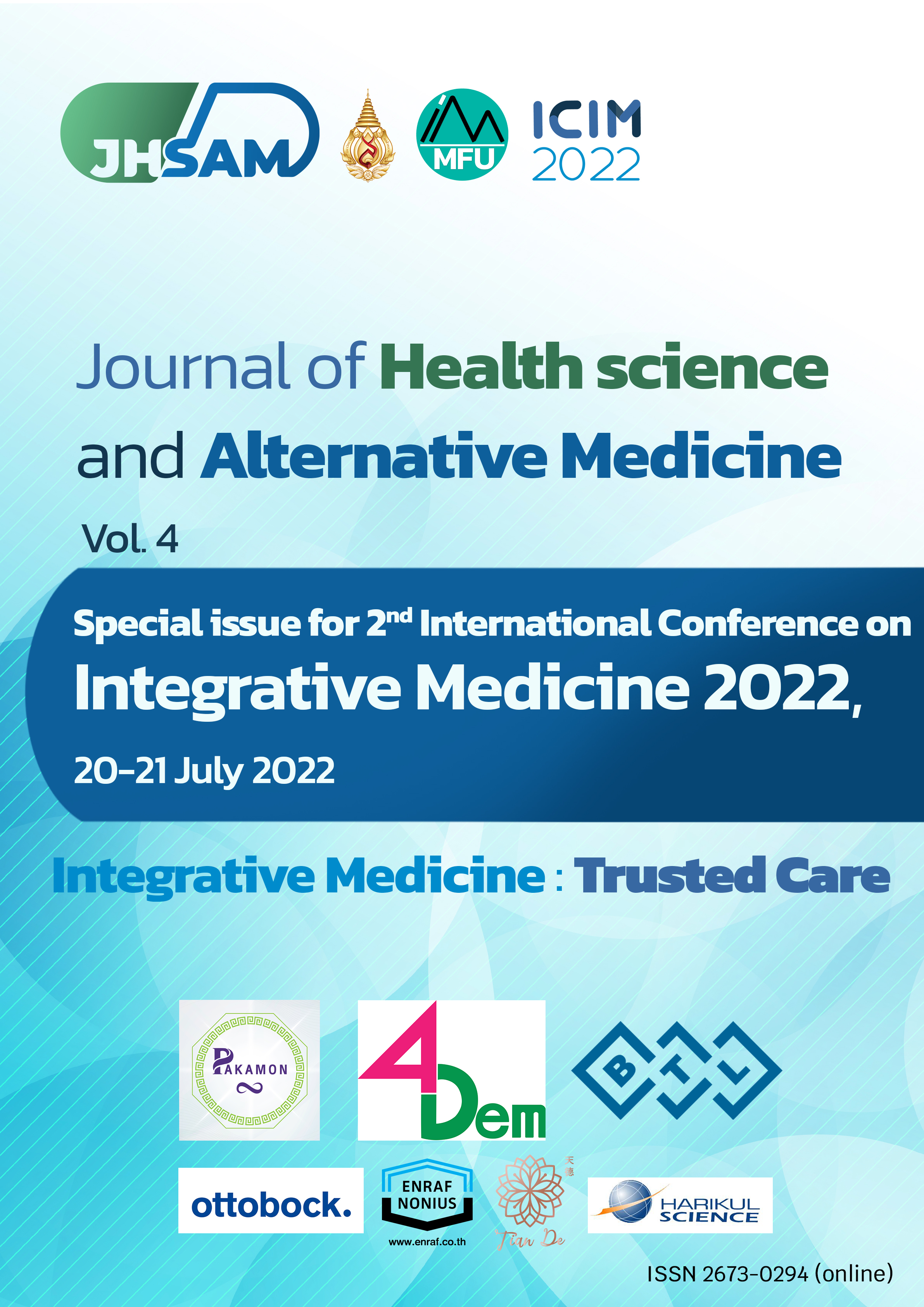D03. Anti-biofilm Potential of Boesenbergia rotunda L. Extract and Synergy with Cloxacillin on Biofilms of β-lactam-resistant Staphylococcus aureus
Main Article Content
Abstract
Introduction: A biofilm is extracellular substances produced by microorganisms to protect themselves from harmful agents, including antibiotics. Bacteria living in biofilms are known to have higher resistance to antimicrobial therapy and is one of the most important mechanisms of resistance to antibiotics. Hence, development of a novel anti-biofilm agent is of far-reaching importance.
Objective: To investigate the anti-biofilm effect of B. rotunda extract (BRE) and its synergism with cloxacillin (CLX) on biofilms of β-lactam-resistant Staphylococcus aureus.
Methods: B. rotunda extract was carried out by macerating with 99.9% ethanol. The extracts were subsequently dried using a rotary evaporator and lyophilized. The anti-biofilm activity and synergistic effect of BRE were carried out by a crystal violet assay. Quantitation of biofilms were done by a spectrophotometer, while qualitative analysis of biofilm formation was observed under a light microscope.
Results: Following 24 h of treatment, the result from quantitative analysis of biofilm formation using a crystal violet assay revealed that BRE significantly eradicated biofilms of β-lactam-resistant S. aureus. Interestingly, the combination of BRE and CLX synergistically inhibited biofilm formation. In line with qualitative analysis of biofilm formation, bacteria treated with BRE and CLX, either alone or in combination, had explicitly lower biofilm than untreated control.
Conclusion: BRE potentially destroyed biofilms and had synergistic effect with CLX in eradication of biofilms of β-lactam-resistant S. aureus. These findings from the evidence that the combination of BRE and CLX could be a good candidate for further development as a novel agent for treatment of recalcitrant infection caused by β-lactam-resistant S. aureus.
Article Details

This work is licensed under a Creative Commons Attribution-NonCommercial-NoDerivatives 4.0 International License.
JHSAM publishes all articles in full open access, meaning unlimited use and reuse of articles with appropriate credit to the authors.
All our articles are published under a Creative Commons "CC-BY-NC-ND 4.0". License which permits use, distribution and reproduction in any medium,
provided that the original work is properly cited and is used for noncommercial purposes.
References
Flemming HC, Neu TR, Wozniak DJ. The EPS matrix: the "house of biofilm cells". Journal of bacteriology. 2007;189(22):7945-7.
Lewis K. Riddle of biofilm resistance. Antimicrobial Agents and Chemotherapy. 2001;45(4):999-1007.
Mah TF, O'Toole GA. Mechanisms of biofilm resistance to antimicrobial agents. Trends Microbiol. 2001;9(1):34-9.
Stewart PS. Multicellular resistance: biofilms. Trends in Microbiology. 2001;9(5):204.
Donlan RM, Costerton JW. Biofilms: survival mechanisms of clinically relevant microorganisms. Clinical microbiology reviews. 2002;15(2):167-93.
Hoiby N, Bjarnsholt T, Givskov M, Molin S, Ciofu O. Antibiotic resistance of bacterial biofilms. International journal of antimicrobial agents. 2010;35(4):322-32.
Lynch AS, Abbanat D. New antibiotic agents and approaches to treat biofilm-associated infections. Expert opinion on therapeutic patents. 2010;20(10):1373-87.
Osei Sekyere J, Govinden U, Essack SY. Review of established and innovative detection methods for carbapenemase-producing Gram-negative bacteria. Journal of applied microbiology. 2015;119(5):1219-33.
Kuzma L, Rozalski M, Walencka E, Rozalska B, Wysokinska H. Antimicrobial activity of diterpenoids from hairy roots of Salvia sclarea L.: salvipisone as a potential anti-biofilm agent active against antibiotic resistant Staphylococci. Phytomedicine. 2007;14(1):31-5.
Coelho F, Pereira M. Exploring new treatment strategies for Pseudomonas aeruginosa biofilm infections based on plant essential oils. Microbial Pathogens and Strategies for Combating them: Science, Technology and Education. 2013;1:83-9.
Venkatesh M, Rong L, Raad I, Versalovic J. Novel synergistic antibiofilm combinations for salvage of infected catheters. Journal of medical microbiology. 2009;58(Pt 7):936-44.
Sandel MK, McKillip JL. Virulence and recovery of Staphylococcus aureus relevant to the food industry using improvements on traditional approaches. Food Control. 2004;15(1):5-10.
Eng-Chong T, Yean-Kee L, Chin-Fei C, Choon-Han H, Sher-Ming W, Li-Ping CT, et al. Boesenbergia rotunda: From Ethnomedicine to Drug Discovery. Evidence-Based Complementary and Alternative Medicine. 2012;2012:25.
Teethaisong Y, Pimchan T, Srisawat R, Hobbs G, Eumkeb G. Boesenbergia rotunda (L.) Mansf. extract potentiates the antibacterial activity of some beta-lactams against beta-lactam-resistant staphylococci. J Glob Antimicrob Resist. 2018;12:207-13.
Gopal R, Kim YG, Lee JH, Lee SK, Chae JD, Son BK, et al. Synergistic effects and antibiofilm properties of chimeric peptides against multidrug-resistant Acinetobacter baumannii strains. Antimicrob Agents Chemother. 2014;58(3):1622-9.
Nithya C, Pandian SK. The in vitro antibiofilm activity of selected marine bacterial culture supernatants against Vibrio spp. Archives of microbiology. 2010;192(10):843-54.
Packiavathy IASV, Priya S, Pandian SK, Ravi AV. Inhibition of biofilm development of uropathogens by curcumin – An anti-quorum sensing agent from Curcuma longa. Food Chemistry. 2014;148(0):453-60.
Yanti, Rukayadi Y, Lee KH, Hwang JK. Activity of panduratin A isolated from Kaempferia pandurata Roxb. against multi-species oral biofilms in vitro. Journal of Oral Science. 2009;51(1):87-95.
Bjarnsholt T. The role of bacterial biofilms in chronic infections. APMIS Supplementum. 2013(136):1-51.
Davies D. Understanding biofilm resistance to antibacterial agents. Nature reviews Drug discovery. 2003;2(2):114-22.
Onsare JG, Arora DS. Antibiofilm potential of flavonoids extracted from Moringa oleifera seed coat against Staphylococcus aureus, Pseudomonas aeruginosa and Candida albicans. Journal of applied microbiology. 2015;118(2):313-25.
Vikram A, Jayaprakasha GK, Jesudhasan PR, Pillai SD, Patil BS. Suppression of bacterial cell-cell signalling, biofilm formation and type III secretion system by citrus flavonoids. Journal of applied microbiology. 2010;109(2):515-27.


